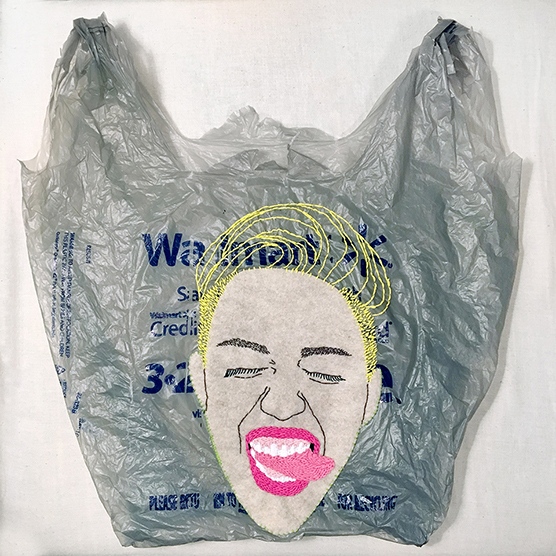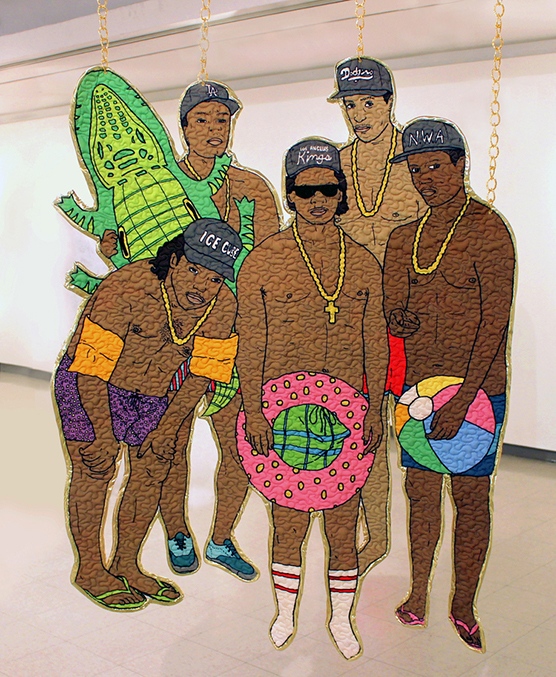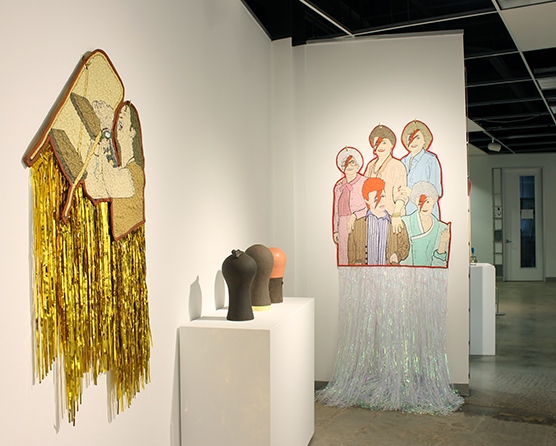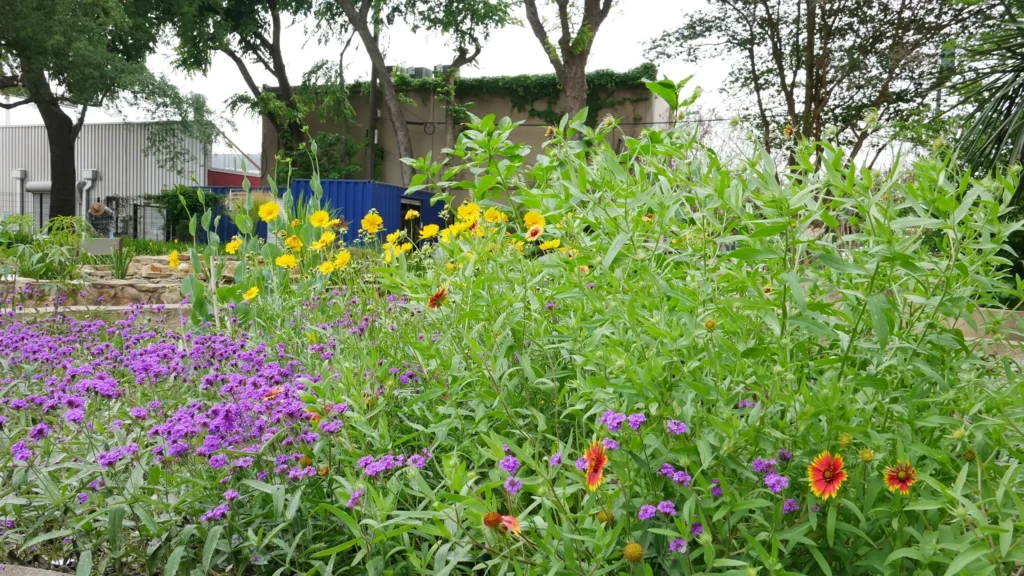Madison Creech, “#TBT Smiley,” from the series, “Always Low Brow Always,” 2016. Hand embroidery on plastic Wal-Mart bag. Photo courtesy of Madison Creech.
HCCC Curatorial Fellow Sarah Darro recently asked Madison Creech a few questions about the processes and inspiration behind her work. Madison is featured in In Residence, which is on view in HCCC’s Artist Hall through May 20, 2017.
Sarah Darro: Your series of sculptural quilts, LOL-a-Bye Felicia, incorporates digital fabrication techniques and humorous references to music and pop culture. How do you see this work in conversation with a contemporary culture of sampling in the music industry and on the Internet?
Madison Creech: Within contemporary culture, we consume information and images without hierarchy. In one scroll through Facebook, you will find a tongue-in-check meme, then a newsworthy injustice, then a series of baby photos, etc. Each update occupies the same amount of space as the next. Our mind is subconsciously making connections and comparisons between the memes, the news, and our personal lives. I feel like a lot of my collaborative work with Matthew [Madison’s husband and artistic partner] consists of iterations of these connections and comparisons.
Madison & Matthew Creech, “Cuz the Boys ‘N the Hood Are Always Hard: N.W.A.,” 2016. Photo courtesy of Madison Creech.
Historically, quilts have been used as a framework for storytelling. Our pieces combine the traditional craft of quilt-making with digital fabrication and image sourcing to engage in contemporary storytelling. The Internet and accessibility of information has impacted my generation’s (and future generations’) experienced nostalgia. Music and celebrity brands are intertwined with our memories.
SD: You have created work in collaboration with dancers Fumihiro Kikuchi and Juan Coel Rodriguez, musician Tony Obr, artists Colleen Donohoe and Molly Koehn, and, most recently, your husband, illustrator, Matthew Creech. How does collaboration function in your practice? Have any of these collaborative projects changed your own approach to art-making?
MC: Collaboration gives me a window into another creative mind, into the usually private studio decisions, mistakes, and uncertain elements before they are erased. Collaborating is luxurious in that way; through observation, my years of art experience can be multiplied. In my practice, I’ve learned there are one of two results that will happen in collaboration. The first result produces art that favors one artist over the other. It becomes obvious which artist was dominant and took the lead on the project. The second result I like to call the “Marina Abramovic and Ulay Collaboration,” in which a third artist is born out of the interactions of the two collaborating artists. In my opinion, neither result is better than the other; both results are valid and natural. Often, when I collaborate, I find my voice quietly in arranging others’ images into patterns, into animations, or onto a malleable surface like fabric.
Madison Creech, Fumihiro Kikuchi, Juan Coel Rodriguez, and Tony Obr,“Zugunruhe,” 2016. Photo courtesy of Madison Creech.
Collaboration has absolutely enriched and changed my work. Grad school is a creative bubble, where other artists are constantly coming in your studio and giving feedback, encouraging you to edit, manipulate, and trash your ideas. Included in the grad-school experience are a slew of deadlines, with repercussions if not met. The intensity is wearing, but it forces you to create good work often. Much like other artists, when my grad-school bubble popped, I craved a creative framework. Collaboration with other creatives was my solution. In the beginning, I worked with my collaborators towards a specific motivating deadline–exhibition date, grant-submission date, performance date. Now that I’ve established a collaborating relationship with a few artists, our goals have changed into creating a body of work together. I’m currently collaborating with an artist collective, FEELD, that includes Ola Lindefelt, Wren Turco, my husband Matthew Creech, and myself. We are interested in the intersection of social practice, alternative money systems, and art. We’ve hosted a bartering event, called DRIFT, and are currently working on a series of digitally printed jumpsuits to be used as anti-camouflage while we lead the community on a walk to forage for invasive edible species in Florida.
Left to right: Yam foraging FEELD project, 2016. Photo courtesy of Madison Creech. FEELD jumpsuit designs, “Antibody03” and “Antibody04,” 2017. Photos courtesy of PAOM.com.
One collaborator in particular has made the biggest impact on my work, my husband Matthew Creech. I’ve found my personal work has expanded to include low-brow and pop-culture motifs. This change is very apparent in my newest series of work, called Always Low Brow, Always, which is comprised of celebrity faces hand embroidered onto Wal-Mart plastic bags. Each featured celebrity has sold a line of product at Wal-Mart.
SD: Much of your work in fiber and print-making can be viewed in the round, subverting traditionally two-dimensional mediums by projecting into three-dimensional space. Often, the backside of your work incorporates materials or textures that subtly enrich the conceptual meaning or tone of the piece. How do you envision viewers interacting with the back of your work? Is it built with the intent of surprise, left to be discovered by those who are particularly attuned and curious?
MC: The definition of a quilt implies layers. With my quilted work, I’m stretching the traditional meaning to include layers of content and sometimes physical layers of stuff. When my husband and I set out to create the series, LOL-a-Bye Felicia, we initially wanted each quilt to be viewed in the round: Matthew’s illustrations on one side and my quirky patterns and assemblages on the other. One of the best examples of a three-dimensional piece is Take My Hand, We are Off to Never Never Land (Ranch), which pays homage to the TY Beanie Baby collection of every Millennial that has ever existed. The back is appliquéd with actual TY Beanie Babies, and a mountain of Beanies is neatly arranged on the floor below. The Beanie motif has come to represent the unfulfilled childhood investments and dreams of the Millennial Generation.
Madison & Matthew Creech, “Take My Hand We are Off to Never Neverland (Ranch),” from the series, “LOL-a-Bye Felicia,” 2016. Digitally printed and quilted cotton, TY Beanie Babies. Photo by Madison Creech.
An element that Matthew and I are continuously drawn to and often use in lieu of a three-dimensional fabrication is metallic-foil fringe. The shiny fringe symbolizes a temporary celebration. It is something that can elevate an average surface to a one-night-only, elegant party table/door/wall/etc. It is also a little tacky. The fringe holds the potential to represent importance but turns out to be all dazzle and no substance.
Madison & Matthew Creech, “Blowin’ in the Wind,” from the series, “LOL-a-Bye Felicia,” 2016. Digitally printed and quilted cotton, metallic-foil fringe. Photo by Madison Creech.
SD: Do you have a female role model that has inspired you and your career? If you do, how has this person influenced your life?
MC: Of course, I’ve learned a lot from looking at works by Anne Hamilton and Sheila Hicks. However, my art has been impacted most by the incredible women artists I’ve known throughout my life. Dana Fritz (www.danafritz.com) showed me what it looked like to be a bad-ass woman boss in academia. She gave me the strongest push to continue to pursue art. The late Judith James (www.judithjamestextileart.com) impressed upon me the tactile nature of textiles and their potential to hold stories. She also introduced me to bias tape binding, which I use in every single quilt. Clare Verstegen was pivotal in helping me understand my story-telling capabilities. The physical nature of my art is heavily inspired by the layers and layers of content and imagery found in Clare’s screen-printed work. Colleen Donohoe (www.colleendonohoe.com)–my first collaborator and one of my closest friends–continues to inspire me with her dedication to equality and justice in her social-practice group, Phoenix Nasty Women Unite. I can count on Colleen to give me honest feedback, and my work has improved immensely because of it. (www.facebook.com/AZNastyWomen/).
Installation view of Madison & Matthew Creech’s works, “‘Can You Take Me Higher’ Scott Stapp,” 2017 (left) and “‘Golden Years’ David Bowie,” 2017 (right). In Residence is on view at Houston Center for Contemporary Craft through May 20, 2017. Photo courtesy of HCCC.
About Madison Creech
Madison Creech is the Brown Visiting Teacher-Scholar Fellow at Stetson University in DeLand, Florida. She holds an MFA in fibers from Arizona State University and a BFA and BS in textile, merchandising, and fashion design from the University of Nebraska-Lincoln. She has served as faculty associate at Arizona State University, instructing surface design, and has held residencies at Houston Center for Contemporary Craft and Techshop, in Chandler, Arizona. Her work has been widely exhibited across the country, and she has been the recipient of a number of distinguished awards, including the Juror’s Award from the Surface Design Association’s Explorations exhibition, the Rudy Turk Award for History in American Craft from ASU, and the Mary Beason Bishop and Francis Sumner Merit Scholarship from the Haystack Mountain School of Crafts. For more information about Madison Creech, please visit, https://www.creechers.com/.







